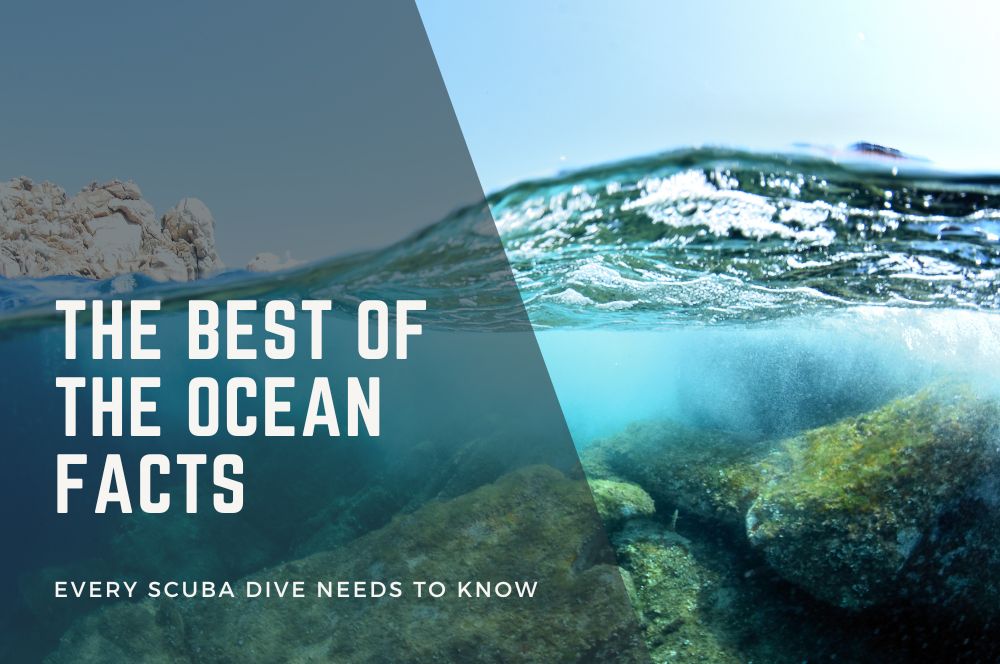You have 0 product(s) in your cart.
Abyss Scuba Diving
The Best Of The Ocean Facts Every Scuba Dive Needs To Know

The Best of the Ocean Facts Every Scuba Dive Needs to Know
Ever wondered what makes the ocean so amazing? Discover the essential “the ocean facts” that uncover the mysteries and key elements of Earth’s vast marine environments. From its immense size to its role in climate, explore why the ocean is vital for our planet. And for those who love scuba diving, dive deeper into the underwater wonders that make our oceans a treasure trove of adventure and discovery.
Key Takeaways
-
Oceans, covering over 70% of Earth’s surface, are vital to our planet’s ecosystem, supporting diverse marine life and regulating the global water cycle.
-
The interconnected nature of the oceans highlights the importance of understanding ocean currents and their role in climate regulation and biodiversity.
-
Exploration and conservation of our oceans are essential as they remain largely unmapped, promising new discoveries and solutions to environmental challenges.
Oceans Cover Most of Earth's Surface

Did you know that oceans cover more than 70% of Earth’s surface? This immense expanse of water is home to a staggering volume of approximately 1,335,000,000 cubic kilometers, emphasizing the vastness of our planet’s marine environments.
Despite their vastness, less than 1% of Earth’s water is fresh, underscoring the oceans’ role in the global water cycle by supplying most evaporated water.
Whether you’re diving in the Pacific Ocean, exploring the Atlantic Ocean, or marveling at the unique marine life in the Southern Ocean, understanding the sheer scale and importance of our oceans is the first step in appreciating their beauty and significance.
The One World Ocean Concept
While we often distinguish oceans by names like the Pacific and Atlantic, they form a single, interconnected global ocean. The One World Ocean concept highlights the unity of Earth’s marine environments.
The world’s oceans are traditionally divided into five major regions:
-
the Pacific
-
Atlantic
-
Indian
-
Arctic
-
Southern Oceans
Despite these distinctions, these bodies of water interact continuously, forming a cohesive global ecosystem that supports diverse marine species and complex ocean currents. This connectivity is vital for sustaining marine life health and stability globally.
Salinity of Ocean Water
The salty nature of ocean water is a defining characteristic that results from the erosion and chemical breakdown of rocks on land, which release minerals into the water. The primary dissolved ions in seawater are chloride and sodium, making up over 90% of the total dissolved ions.
On average, the salinity of ocean water is about 35 parts per thousand, meaning that 3.5% of seawater’s weight consists of dissolved salts. Incredibly, a cubic mile of seawater can contain around 120 million tons of salt.
Additionally, seawater can hold trace amounts of precious metals, including up to 25 pounds of gold and 45 pounds of silver per cubic mile. Grasping salinity helps us appreciate ocean water’s unique properties and its impact on marine ecosystems.
Depths of the Ocean
The depths of the ocean are as varied as they are mysterious. On average, the ocean is about 3.7 kilometers deep, featuring a complex landscape that includes canyons, seamounts, and vast abyssal plains. The continental shelves, which reach depths of about 300 feet, are particularly productive marine environments due to their light and nutrient availability.
While the Atlantic Ocean has relatively shallow floors due to its extensive continental shelves, the Pacific Ocean is home to deeper regions, including the Mariana Trench, the deepest point on Earth, plunging to approximately 36,201 feet.
Abyssal plains, found at depths exceeding 10,000 feet, cover about 70% of the ocean floor and are characterized by their dark and cold ecosystems. These depths harbor unique marine life forms adapted to extreme conditions.
The Dynamic Nature of Ocean Currents
Ocean currents are the lifeblood of the world’s oceans, constantly moving seawater across the globe. These currents are influenced by wind, water density, and tidal forces, existing both on the surface and at great depths. One of the most critical processes driving these currents is thermohaline circulation, which relies on differences in water temperature and salinity.
The Coriolis effect, a result of Earth’s rotation, causes ocean currents to deflect to the right in the Northern Hemisphere and to the left in the Southern Hemisphere. These currents transfer heat from tropical regions to polar areas, playing a significant role in regulating local and global climates.
Ocean currents function like a conveyor belt, moving warm water from the equator to the poles and returning cold water to the tropics.
Biodiversity in the Ocean

The ocean is a treasure trove of biodiversity, hosting an incredible array of marine life. Biodiversity hotspots, such as coral reefs and certain coastal regions, support high numbers of unique species and critical biological processes. This diversity boosts marine ecosystems’ resilience, enabling them to function despite species decline.
Interactions like the symbiotic relationships between sea anemones and fish, and the role of primitive organisms like sea sponges in filtering water, illustrate the complexity and interdependence of marine life. Bioluminescence in the deep sea, which aids in activities such as finding food and defense, further highlights the remarkable adaptations of ocean species.
Ocean currents also play a vital role in transporting nutrients and larvae, affecting the reproduction of various marine species.
Coral Reefs: Rainforests of the Sea
Coral reefs, often referred to as the rainforests of the sea, are among the most biodiverse ecosystems on the planet. Despite covering less than 1% of the ocean floor, coral reefs host over a quarter of all marine species. This high biodiversity makes them resilient to environmental changes and helps them recover from disturbances.
Parrotfish play a crucial role in maintaining reef health by consuming algae and grinding up coral, which helps prevent the overgrowth of harmful algae and promotes the growth of new coral. The Great Barrier Reef, among other coral reefs, exemplifies the vibrant and complex nature of these ecosystems, making them a vital part of the ocean’s biodiversity.
Oxygen Production by Marine Plants
Marine plants, particularly phytoplankton, are critical to our ecosystem, producing about 50% of the Earth’s oxygen through photosynthesis. A newly discovered cellular mechanism in phytoplankton contributes significantly to this oxygen production, enhancing the availability of carbon dioxide for photosynthesis.
Upwelling currents, which bring nutrient-rich water from the ocean depths to the surface, support the growth of phytoplankton and sustain important fisheries. The oxygen produced by these marine plants is essential for the survival of both marine and terrestrial life, underscoring the importance of protecting these vital organisms.
The Impact of Plastic Pollution
Plastic pollution is a growing threat to the health of our oceans. The Great Pacific Garbage Patch, a massive accumulation of plastic debris, is a stark reminder of this issue. Composed mainly of microplastics, these tiny fragments can make the water appear cloudy and are difficult to see, posing significant harm to marine life.
Marine animals often suffer from entanglement in plastic debris, particularly abandoned fishing nets, which can cause injuries or death. Ingestion of plastic can also lead to severe health problems for marine animals, as it occupies space in their stomachs and inhibits their ability to eat real food.
Preventing marine debris is vital, as littering and poor waste management exacerbate ocean pollution.
Underwater Mountains and Trenches

The ocean floor hosts some of Earth’s most dramatic geological features, like underwater mountains and trenches. The mid-ocean ridge, an extensive underwater mountain range, stretches over 40,000 miles and is formed by tectonic plate movements. These underwater mountains are teeming with marine life, creating unique ecosystems.
The Mariana Trench, located in the Pacific Ocean, is the deepest ocean trench, reaching depths of approximately 10,994 meters. Ocean trenches generally lie in the hadalpelagic zone, characterized by intense pressure and a complete absence of sunlight.
Accretionary wedges, formed from the sediments scraped off subducting plates, can even create island formations above these trenches. The Challenger Deep, the deepest part of the Mariana Trench, experiences pressure exceeding 12,400 tons per square meter, illustrating the extreme conditions of these underwater landscapes.
Bioluminescence in the Deep Sea
Bioluminescence is a captivating phenomenon in the deep sea. This light-emitting ability is present in many deep-sea organisms, particularly within the pelagic zone, where about 80% of creatures at depths of 200 to 1,000 meters are bioluminescent. The predominant color of bioluminescent light is blue, as it penetrates water most effectively, although it can also appear in shades ranging from violet to green-yellow.
Different species of bioluminescent organisms utilize various chemicals in the light-production process, indicating that this ability may have evolved independently multiple times. This remarkable adaptation aids in finding food, reproductive processes, and defense mechanisms, making it a crucial survival strategy in the deep, dark ocean.
The Importance of Ocean Exploration

Despite the vastness of our oceans, more than 80% remain unexplored and unmapped. We know more about the surface of the moon than the depths of the ocean. Exploring the ocean is key to understanding unique ecosystems, managing resources sustainably, and discovering new medical and technological advancements.
The challenges of deep-sea exploration, such as high pressure, strong currents, and lack of visibility, require advanced engineering and innovative technologies. The data gathered from these explorations help us address both existing and emerging scientific and management challenges, including the impacts of climate change and natural hazards like tsunamis and underwater landslides.
Climate Regulation by Oceans
Oceans significantly regulate global temperatures by absorbing and releasing heat. This ability is particularly significant in tropical regions, where oceans absorb vast amounts of solar radiation. The Gulf Stream and other ocean currents help distribute this heat, influencing local and global climates.
Approximately 97% of the earth’s oceans’ water is contained within the oceans, illustrating their vastness and significance. By regulating global temperatures and absorbing greenhouse gases, oceans help mitigate the effects of climate change, making their health and stability vital for the planet.
Rising Sea Levels

Rising sea levels are a pressing concern, primarily caused by the melting of glaciers and ice sheets, along with the thermal expansion of seawater as it warms. Melting glaciers have significantly increased in recent decades, with losses from the Greenland Ice Sheet rising dramatically. Since 1880, the global average sea level has increased by approximately 8-9 inches (21-24 centimeters).
The rate of sea level rise has more than doubled from an average of 0.06 inches per year in the 20th century to 0.14 inches per year from 2006 to 2015. This rise poses significant risks to urban infrastructure, increases the frequency of high-tide flooding, and threatens freshwater aquifers with saltwater intrusion.
Future projections suggest that under high greenhouse gas emissions, average sea level in the contiguous United States could rise by 2.2 meters by 2100.
The Role of Oceanographers
Oceanographers play a vital role in understanding and protecting ocean health. Studying the ocean’s biological, physical, and chemical properties provides crucial insights into marine life and ecosystems. Their research helps manage and conserve ocean resources effectively, particularly in understanding the effects of pollution on fish populations.
Geological oceanographers use advanced GPS technology to map the seafloor, assessing changes over time and enhancing our knowledge of underwater landscapes.
Public engagement in ocean exploration enhances appreciation for the marine environment and encourages STEM careers, bolstering oceanographic research.
Interesting Facts About Marine Animals
Marine animals exhibit a variety of unique adaptations that enable them to survive in diverse environments. For instance, sharks’ skin is covered with dermal denticles, giving it a texture similar to sandpaper, which reduces drag and helps them swim efficiently.
The ocean hosts about one million species, each with distinct characteristics and survival strategies. From the massive blue whale to the tiny plankton, the diversity of marine life is astonishing and a testament to the ocean’s rich and complex ecosystems.
Summary
In summary, the ocean is a vast and vital part of our planet, covering over 70% of Earth’s surface and playing a crucial role in the water cycle, climate regulation, and supporting a diverse array of marine life. Understanding the interconnectedness of the world’s oceans, the salinity of ocean water, the depths and currents that shape marine environments, and the rich biodiversity within are essential for appreciating and protecting this incredible ecosystem.
As scuba divers and ocean enthusiasts, it is our responsibility to learn about and advocate for the health of our oceans. Whether it’s raising awareness about plastic pollution, supporting ocean exploration, or simply marveling at the wonders of marine life, every action counts. Let’s continue to explore, learn, and protect the deep blue sea for future generations.
Frequently Asked Questions
How much of Earth's surface do oceans cover?
Oceans cover over 70% of Earth's surface, showcasing their vastness and significance in shaping our planet. This remarkable presence reminds us of the beauty and power of nature.
What is the One World Ocean concept?
The One World Ocean concept emphasizes that even though oceans are categorized into five regions, they are all interconnected, creating a unified global ecosystem that we can all cherish and protect. Embracing this concept encourages us to take collective action for ocean conservation!
What is the average salinity of ocean water?
The average salinity of ocean water is approximately 35 parts per thousand, which translates to 3.5% of its weight being made up of dissolved salts. This fascinating fact highlights the ocean's unique chemistry!
Why is ocean exploration important?
Ocean exploration is vital for uncovering unique ecosystems and sustainable resource management, while also holding the potential for new medical and technological breakthroughs. By exploring the ocean, we can unlock its many wonders and benefits for our future!
What are the primary causes of rising sea levels?
Rising sea levels are primarily caused by the melting of glaciers and ice sheets, along with the thermal expansion of warming seawater. Understanding these factors empowers us to take action for a healthier planet!
Recent Posts






